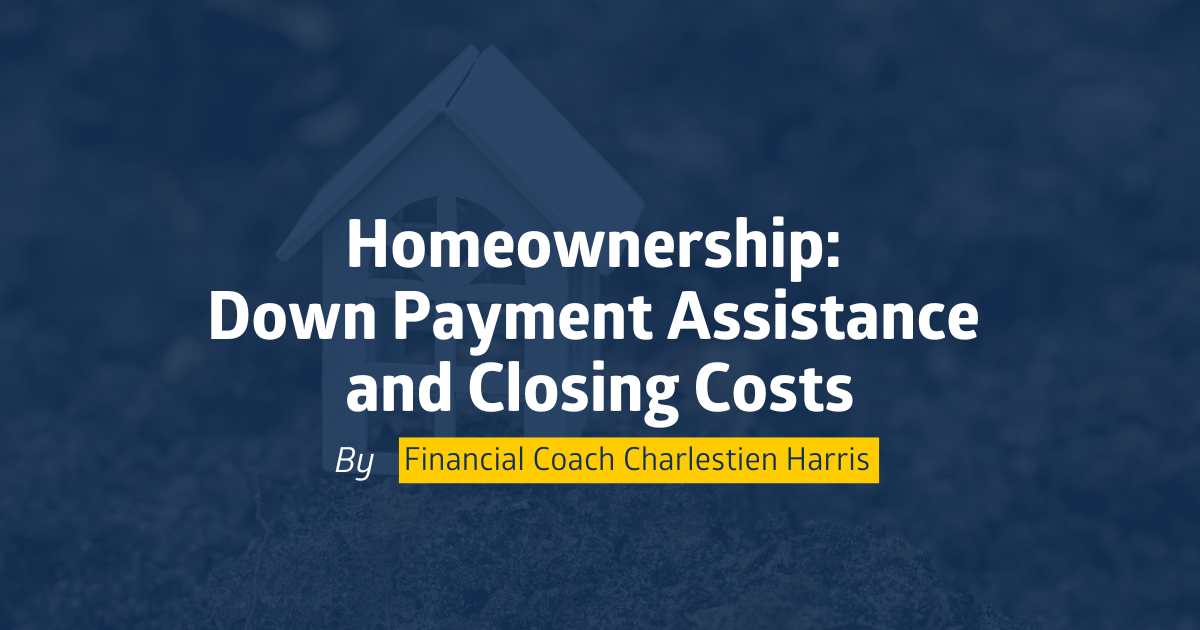By Charlestien Harris
Throughout the month of June, I have been writing about National Homeownership Month. As I wrap up talking about homeownership, I would like to close out this month by discussing two very important topics that are vital to the process of purchasing a home – down payment and closing costs.
First-time home buyers can usually qualify for assistance and should ask their financial institution about availability. A first-time home buyer, according to HUD, is defined as an individual who has had no ownership in a principal residence during the three-year period ending on the date of purchase of the property. Now, let’s talk about down payment assistance and closing cost assistance programs. Understanding how these programs may benefit you can help you to understand the process better and also help you to make a more informed decision. I would like to start by first defining what down payment and closing costs are.
- Down Payment: Understanding why having a down payment is so important because having it can lower the overall cost of purchasing a home. A down payment is a sum a buyer pays upfront when purchasing an expensive good such as a home or car. It represents a percentage of the total purchase price, and the balance is usually financed. Putting money down on a house also helps lower your total loan amount. The less money you borrow, the more money you save on interest over the life of the loan. A larger down payment may help you purchase a higher-priced home or get a lower interest rate. There are several ways you can be prepared to have a down payment ready when the purchase time comes for the potential homeowner. Some of those options may include contributing to a savings account, gift funds from a relative or friend, getting a part-time job, or inquiring about down payment and closing costs assistance programs.
- Closing Costs: Closing costs are fees and expenses that buyers and sellers pay to complete a real estate transaction, in addition to the property’s price. These costs are not part of the negotiated price and are paid to various third parties. Closing costs can vary depending on the loan size and local taxes and fees. Closing costs are a necessary expense to ensure a smooth real estate transaction. If you’re buying a home, you should budget for closing costs between 2 percent and 6 percent of the purchase price. If you’re selling a home, you should budget for closing costs between 6 percent and 10 percent of the purchase price. Some of the items that can be included in closing cost fees are loan origination fees, discount points, appraisal fees, title searches, title insurance, surveys, taxes, deed recording fees, credit report charges, and attorney fees. By no means is this an exhaustive list, but it does give you as a potential homeowner a pretty good idea what kind of fees can be included in your paperwork.
What is down payment assistance?
Down payment assistance (DPA) programs offer loans and grants that can cover part or all of a home buyer’s down payment and closing costs. There are more than 2,000 of these programs available nationwide. Usually, state, county, and city governments run many of them and some financial institutions will have access to some of those funds as well. DPA programs vary by location, but many home buyers could be in line for thousands of dollars in down payment assistance if they qualify.
There are several ways a potential homeowner can access down payment and closing cost assistance programs. Down payment assistance programs are typically meant for first-time home buyers. However, a repeat home buyer often counts as a “first-time buyer” if they haven’t owned a home in the past three years.
Some requirements to qualify for down payment assistance:
- First-time home buyer
- Low- to moderate-income
- Buying a primary residence
- Buying within local purchase price limits
- Using an approved mortgage program
- Working with an approved mortgage lender
Keep in mind that every down payment assistance program is a little different. The exact criteria to qualify will depend on where you live and which programs are available. In addition, you could get more money and qualify easier if you’re buying in a so-called “target area.” Your lender can help determine if your property is eligible. Down payment assistance (DPA) helps home buyers with grants or low-interest loans, reducing the amount they need to save for a down payment. Provided you qualify, you could receive a forgivable loan or an outright cash gift that never has to be repaid. Some loans must be repaid with low or no interest. Many DPAs can be used for closing costs, too. Almost all DPA programs require you to borrow from an approved lender and use an approved mortgage program. You may have to sign up for a particular mortgage product.
There are four main types of down payment assistance:
- Grants: Gifted money that never has to be repaid.
- Loans: Second mortgages that are paid monthly along with your primary mortgage.
- Deferred loans: Second mortgages with deferred payments that only have to be paid when you move, sell, or refinance.
- Forgivable loans: Second mortgages that are forgiven over a set number of years (often five, but maybe up to 15 or 20). These only need to be repaid if you move, sell, or refinance too early.
June is celebrated as National Homeownership Month, but you can find information about the home-buying process during the entire year. Southern Bancorp is a HUD-approved housing counseling agency and we have staff that are HUD-certified counselors. We also have in-house down payment assistance programs available, one of which provides up to $12,000 as a forgivable loan for qualified home buyers.
For additional information on this and other financial topics, visit our blog at banksouthern.com/blog, email me at Charlestien.Harris@banksouthern.com, or call me at 662-624-5776.
Until next week – stay financially fit!
